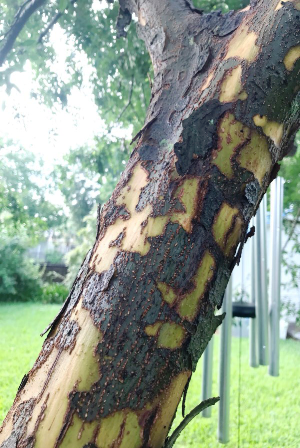So often we choose a tree because of its flowers, leaves, fall color, or its fruit. Often we forget about the bark. However on many trees, the bark is the most interesting part of the tree. This can be especially true on deciduous trees that lose their leaves in the winter. The bark can be a feature that adds tremendous interest to a tree.
What is Bark
What exactly is bark and what does it do? Bark is a layer of dead cells made up of compressed phloem, and cork. The bark is like the armor of the tree. It protects the tree from being injured from animals, insects or disease. To do this the bark of some trees have thorns, while others actually contain chemicals that taste bad to insects. Bark also insulates the cambium from heat and cold. The thick bark of pine trees protects all important cambium from fire. The layer of tissue under the bark is called the phloem. This tissue distributes the carbohydrates made in the leaves throughout the tree. Without bark protect-ing the phloem tissue, the tree would starve and the wood of the tree would dry out. Bark also needs to be a little elastic. As a tree grows in diameter, the bark needs to grow along with it.
Humans have used bark for many different products. Bark was used to make baskets, some clothing and as a covering for canoes. Today, bark is still used in many things. Bottle corks are made from the bark of the cork oak. Cinnamon comes from the bark of the Cinnamomum verum tree. Bark is even used in the formation of several medicinal products including some pro
mising cancer treatments. The original source for aspirin was from the bark of willow trees.
Is Peeling Bark Bad
So back to the original question. Is peeling or loose bark bad? The answer depends on what is under the peeling bark. If the loose bark reveals “wood”, then this means the

tree has been wounded to the extent that the bark is no longer attached to the tree. If the wound is small, most of the time the tree can create woundwood to cover over it. If it is extensive such as the case of a vehicle hitting a tree, then only time will tell. The treatment would be to remove all the loose bark in a process called bark tracing. Do not remove bark that is tightly attached. There is no need to apply any wound sealant such as tar, or pruning paint. These products actually interfere with the wound closure process.
If there is more bark under the loose bark then the tree is fine. In this case the loose bark indicates that the tree is growing enough that the old bark is splitting revealing the newer bark underneath.

There are many trees that have interesting bark that is loose or peeling. Some of the more common trees in our area with peeling bark include river birch, lacebark elm, crape myrtle, sycamore and bald cypress. When you want to add some additional interest to your landscape consider using trees that have unusual, or interesting bark.
 1
1
